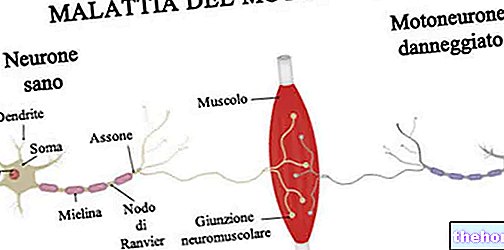
A transmissible type of condition, the mad cow seems to be due to a modified form of a normal protein expressed in almost all mammals, whose name is prion.
After a completely asymptomatic incubation period of 3 to 5 years, the mad cow begins to manifest itself, with symptoms such as: tremors, myoclonus, problems with balance and motor coordination, abnormal gait, difficulty getting up, changes in behavior and hyper-reactivity to stimuli.
Mad cow disease is a disease for which there is no cure except some symptomatic treatment.
Mad cow disease is a condition of considerable interest to humans since some UK residents developed an equivalent neurological disease in the mid-1990s after consuming the meat of sick cattle.
Brief reminder of Encephalopathies
Encephalopathies represent a group of non-inflammatory neurological diseases, characterized by a "structural alteration" of the brain that affects the functions of the latter and in general the so-called mental state.
Congenital or acquired, an "encephalopathy can be a permanent and incurable condition (permanent encephalopathy) or a condition that has a more or less considerable margin for healing (temporary encephalopathy).
To distinguish one "encephalopathy" from another are: the causes (to which the specific name of the disease is usually due), the symptoms, the possible complications, the expected treatment and the prognosis.
Generally speaking, those suffering from an encephalopathy develop numerous disorders, including for example memory deficits (especially amnesia), depression, personality changes, inability to solve simple problems of everyday life, lethargy, myoclonus and tremors.
The Mad Cow as a Transmissible Disease
Thanks to its transmissibility, the mad cow is included in the "list of so-called transmissible spongiform encephalopathies (or TSE); transmissible spongiform encephalopathies are the spongiform encephalopathies that a healthy subject can develop if he ingests the tissues of an affected subject.
Like the mad cow are transmissible spongiform encephalopathies: kuru, fatal familial insomnia, Gerstmann-Sträussler-Scheinker syndrome, Creutzfeldt-Jakob disease, the new variant of Creutzfeldt-Jakob disease, scrapie, encephalopathy feline spongiform encephalopathy, mink spongiform encephalopathy, exotic ungulate encephalopathy and chronic wasting disease of the deer.
Known transmissible spongiform encephalopathies
Human being
Mad Cow and Human Being: the connection
The mad cow represents a topic of extreme interest for the "human being, since - as will be seen a little later - in the mid-90s, in correspondence with a" BSE epidemic that took place in the United Kingdom , a not insignificant percentage of people fell ill with a neurological disease very similar to Creutzfeldt-Jakob disease, after consuming meat belonging to sick cattle.
This neurological disease very similar to Creutzfeldt-Jakob disease is the aforementioned new variant of Creutzfeldt-Jakob disease.
The new variant of Creutzfeldt-Jakob disease can be considered the human equivalent of the mad cow.
A bit of History of the Mad Cow
The first identified cases of mad cow go back to 1986; the place of the discovery was a cattle farm in the United Kingdom.
From that moment on, in the United Kingdom, a sort of BSE epidemic began, which reached its peak in 1993 (a period in which, according to the statistics of the time, there were 1000 new cases of sick cattle at week) and slowly ran out, thanks to a series of government measures, in the following years (in 2015 there were only 2 cases of mad cow registered).

According to industry experts, the "mad cow epidemic" was initiated by the use, in UK cattle farms, of feed based on animal meal, which contained minced meat and bones from cattle affected by a sporadic form of BSE (remember that mad cow disease is a communicable disease).
Beyond the impressive numbers reached, the mad cow epidemic that took place in the United Kingdom had a strong echo not only in Europe, but also worldwide, for another reason: a few years after the first cases of BSE, a percentage not negligible of British citizens began to develop, as a consequence of the consumption of meat from cattle suffering from bovine spongiform encephalopathy, a new neurological disease, very similar to Creutzfeldt-Jakob disease (ie the new variant of Creutzfeldt-Jakob disease).
According to a June 2014 statistics, 177 people became ill with the new variant of Creutzfeldt-Jakob disease, as a consequence of the effects of the "BSE epidemic in the United Kingdom starting in the late 1980s".
, the prion is, in its healthy variant, a glycoprotein which is most likely responsible for signal transduction or cell adhesion (there are still doubts about the precise role).
PRION AS A CAUSE OF MAD COW
The idea that the prion is involved in the insurgence of mad cow disease is the result of two equally important observations:
- First observation: modified forms of the prion protein are present in cattle with BSE. By modified forms of the prion protein, it is meant that the prion has an abnormal conformation, different from normal.
- Second observation: in the modified variant, the prion loses its function as a glycoprotein and acquires such properties that make it harmful to the brain and nervous tissue in general as well as capable of transforming normal prions (ie in the healthy variant) into modified prions.
In light of these two important observations, the experts compared the prion to a kind of infectious agent (that is, they equated it with a virus or bacterium), also assigning it the alternative names of "unconventional infectious agent" and "infectious particle." protein only ".
The modified form of the prion is responsible for a devastating chain reaction; its manifestation, in fact, involves the progressive modification of the normal prions, present in the affected subject, and the formation of protein aggregates which, after having affected the brain in several points, cause the death of the nervous tissue, creating real holes in it (the spongiform aspect that characterizes the brain of cattle with BSE is the result of the creation of these holes).
OTHER CHARACTERISTICS OF THE MODIFIED PRION
Scientific studies on the prion have shown that:
- The prion is also smaller than viruses (which are the smallest infectious agents);
- The prion is incredibly resistant to the most classic procedures used to eliminate viruses, bacteria, fungi or other known microorganisms. This explains why cooking meat from mad cow-affected cattle does not destroy the modified prion present.
PRION AND OTHER DISEASES
According to those who see the prion as the cause of mad cow disease, the same prion is also implicated in all known transmissible spongiform encephalopathies; in other words, the prion would be responsible for the appearance of: Creutzfeldt-Jakob disease, the new variant of Creutzfeldt-Jakob disease, kuru, Gerstmann-Sträussler-Scheinker syndrome, "feline spongiform encephalopathy," Mink spongiform encephalopathy etc.
Obviously, the idea that the prion is also involved in other known transmissible spongiform encephalopathies derives from scientific observations similar to those reported for the mad cow (presence of modified prion in sick animals and modified prion capable of attacking the brain, causing damage) .
In pathology, diseases that doctors believe are related to the modified prion (such as transmissible spongiform encephalopathies) are also called prion diseases.
Incubation times
The mad cow has long incubation times; in fact, the bovine that comes into contact with the causative agent of the disease - the modified prion, if that were the cause of the condition - develops the disease within the next 3-5 years.
Did you know that ...
When the human being contracts the human equivalent of the mad cow by ingestion of contaminated beef, he could manifest the neurological disease even after more than 10 years from the aforementioned ingestion event.
According to the most recent studies, the average incubation period of the human equivalent of the mad cow would be 13 years.
Transmission of the Mad Cow to the Human Being
The transmission of the mad cow to the human being can occur only by ingestion of meat belonging to a bovine with BSE.
The mad cow, therefore, is not like a cold or contagious infectious diseases, in which even the simple proximity between the healthy subject and the sick subject is sufficient for the transmission of the disease.
Fun fact: does milk from a BSE-affected cow transmit the disease?
Drinking the milk of a BSE-affected cow or eating the latexes made from this milk is not enough to cause the human equivalent of mad cow.
),
- Difficulty getting up
- Hyper-reactivity to certain stimuli e
- Behavior changes (affected animals suddenly become aggressive or appear strangely nervous),
and less common or less specific disorders, such as:
- Tendency to continuous rubbing or licking,
- Weight loss,
- Continuous grinding of teeth,
- Recurrent ear infections e
- Decrease in milk production.
Mad Cow is a Fatal Disease
Mad cow disease is always a fatal disease.
Affected animals typically go into a coma before death.
Death from BSE occurs a few weeks or months after the onset of symptoms.
The Symptoms of the Mad Cow in Human Being
In the "human being," the equivalent of the mad cow (ie the new variant of Creutzfeldt-Jakob disease) is responsible, at the end of the incubation period, for:
- Psychiatric symptoms, including depression, anxiety, withdrawal disorders, etc .;
- Progressive loss of motor coordination (ataxia);
- Sensory disturbances;
- Dementia;
- Myoclonus (short, involuntary contraction of a muscle or group of muscles).
The new variant of Creutzfeldt-Jakob disease has always existed fatal, just like mad cow disease and other known transmissible spongiform encephalopathies; people who develop this disease usually die within 14 months.
and sodium valproate against myoclonus).




























